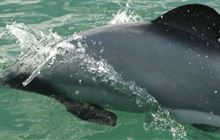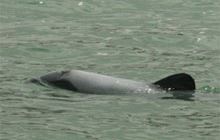Māui dolphin abundance estimate
Introduction
Every five years DOC undertakes an abundance estimate of the population of the critically endangered Māui dolphin population.The survey on takes place on the west coast of the North Island. This same approach has been used for estimating some Hector’s dolphin sub-populations and is ideal for assessing small populations.
This work is a key aspect of our programme to protect Māui dolphins. It involves analysing DNA profiles of individual dolphins taken from biopsy samples obtained from the animals during dedicated small-boat surveys. The surveys go as far north as the entrance of Kaipara Harbour and as far south as the Mokau River, Taranaki, although most effort is concentrated between Raglan Harbour and Muriwai.
The DNA profiles are collected by firing a small, lightweight biopsy dart from a modified veterinary capture rifle into live free-swimming dolphins from the survey boat. The biopsy dart hits and bounces off an animal removing a tiny plug of skin and associated blubber. The samples collected are relatively small, only about 4 mm by 10 mm. Calves, distinguishable by their small size, are excluded from sampling.
This method of sampling provides a tiny genetic sample from which it is possible to derive vital information about the dolphins in the survey area such as:
- The ‘effective population size’ (estimates the effective number of breeding adults in the parental generation).
- An indication of the genetic diversity within the population.
- An estimate of how many are males and how many are females in the population.
- How much individual animals move around over both the short-term (i.e. days) and long-term (months/years).
- An understanding of the whakapapa of individual animals.
This method has been successful in 2011, 2016 and 2021 to derive abundance estimates for the Māui dolphin population. We’re confident the methodology is robust and follows best practice. Using uniquely identifiable individuals to estimate the size of a population has been a standard method in marine mammal science since the first publication in the late 1970s recognising that photos of fins could be used to uniquely identify bottlenose dolphins.
The most recent Māui dolphin abundance survey was completed in 2021, and you can find the results of that survey on this page.
2020-21 abundance estimate
In 2020 DOC and Ministry for Primary Industries, in collaboration with Auckland and Oregon State Universities, began a repeat of the abundance estimate of Maui dolphins.
The revised population estimate was carried out over two summer seasons, 2020 and 2021. The 2020 and 2021 field reports are available below.
Key findings
- The abundance of Maui dolphins over 1 year of age was estimated to be 54 with a 95% confidence interval of 48 to 66 (this means that the researchers are 95% confident that there are between 48-66 Maui dolphins over the age of 1 year within the survey area).
- Over both years a total of 84 biopsy samples were collected from a total of 43 individual dolphins.
- 22 of these individuals were females
- 13 individuals were sampled in both years
- 41 individuals were identified as Maui dolphins
- 2 individuals (one male and one female) were identified as Hector’s dolphins, both sampled in 2020 and not resampled in 2021. The female Hector’s dolphin was first identified in 2010, while the male had not been sampled previously.
The 2020 and 2021 field seasons were successful in matching the effort of the 2010/2011 surveys and the 2015/2016 surveys, with a comparable number of surveys, duration of the survey period and coverage of the primary known habitat for Maui dolphins.
Reports
Estimating the abundance and effective population size of Māui dolphins in 2020 – 2021 using microsatellite genotypes, with retrospective matching to 2001:
Māui dolphin biopsy sampling survey field reports and preliminary results:
Previous abundance estimates


